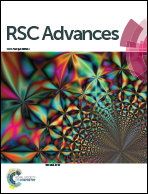Hypervalent iodine(iii) catalyzed oxidative C–N bond formation in water: synthesis of benzimidazole-fused heterocycles†
Abstract
An iodine(III) catalyzed C(sp2)–H functionalization–intramolecular amination reaction of N-aryl-2-amino-N-heterocycles has been developed in water and under ambient conditions. This metal-free open-flask chemistry is general and successfully applied in synthesizing the benzimidazole-fused heterocycles pyrido[1,2-a]benzimidazole, benzimidazo[1,2-a]quinoline and benzimidazo[2,1-a]isoquinoline derivatives.


 Please wait while we load your content...
Please wait while we load your content...